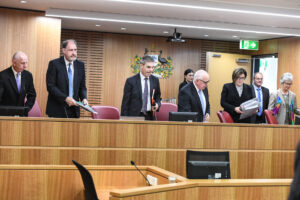More Resources on Australia’s Wages Crisis
The debate over wages, prices, and living standards heated up even further this week, with the release of new ABS statistics showing continuing weakness in wages despite the acceleration of inflation. The latest data from the ABS Wage Price Index (WPI) shows nominal wages grew just 2.4% over the 12 months ending in March. That is less than half as fast as consumer prices grew (5.1%), producing the biggest decline in real wages this century.
Our Centre continues to develop resources documenting the dimensions and causes of declining real wages, and countering the claim that trying to protect real living standards (by boosting wages at least as fast as inflation) will somehow cause hyperinflation and economic ruin.
Our new landmark report, The Wages Crisis: Revisited, provides comprehensive data on the scale of Australia’s wage slowdown – which began in earnest around 2013. Even after the dramatic events of the COVID-19 pandemic, and the surprising decline in the official unemployment rate (now slightly below 4%), wage growth has only regained the same sluggish pace demonstrated for several years before COVID. And with consumer price inflation accelerating, weak nominal wage growth is now corresponding to major erosion in real wages.
The three authors of that report – Prof Andrew Stewart from the Adelaide Law School, Assoc Prof Tess Hardy from Melbourne Law School, and the Centre for Future Work’s Director Jim Stanford – participated in a webinar hosted by our colleagues at the Australia Institute. They reviewed the main findings of the report, and answered several questions from the audience about the wages crisis and possible solutions. The webinar was hosted by Ebony Bennett, Deputy Director of the Australia Institute.
Our team has also been working to analyse the implications of the latest wages data for real incomes, macroeconomic performance – and the federal election, in which wages have emerged as a major point of contention. Please see the following analysis from our team:
- Proof positive. Real wages are shrinking, Wednesday’s figures put it beyond doubt, by Jim Stanford (Economist and Director), in The Conversation.
- Australian wages in real terms are essentially no different from where they were in 2013, by Greg Jericho (Policy Director, Labour Market and Fiscal), in The Guardian.
- WPI: Worst Real Wage Decline This Century, news release from Greg Jericho (Policy Director, Labour Market and Fiscal) and Matt Grudnoff (Senior Economist, The Australia Institute).
Our team will continue to research the dimension, causes, consequences, and potential solutions to the worsening wages crisis in the coming weeks — no matter who wins Saturday’s election!
Between the Lines Newsletter
The biggest stories and the best analysis from the team at the Australia Institute, delivered to your inbox every fortnight.
You might also like
Analysis: Will 2025 be a good or bad year for women workers in Australia?
In 2024 we saw some welcome developments for working women, led by government reforms. Benefits from these changes will continue in 2025. However, this year, technological, social and political changes may challenge working women’s economic security and threaten progress towards gender equality at work Here’s our list of five areas we think will impact on
The continuing irrelevance of minimum wages to future inflation
Minimum and award wages should grow by 5 to 9 per cent this year
Go Home on Time Day 2024: Exposing the $91 billion rip-off smashing exhausted Aussie workers
Despite new Right to Disconnect laws coming into force earlier this year, new research reveals Australians are still working an average five weeks’ unpaid overtime each year.



